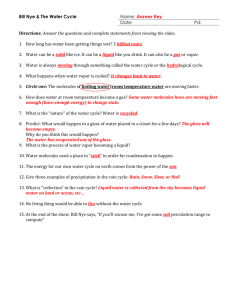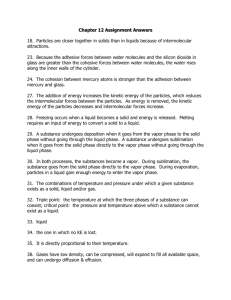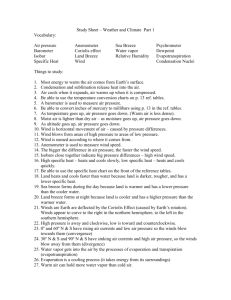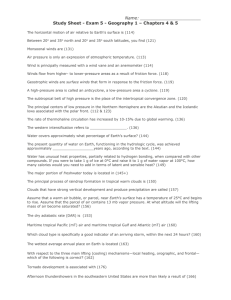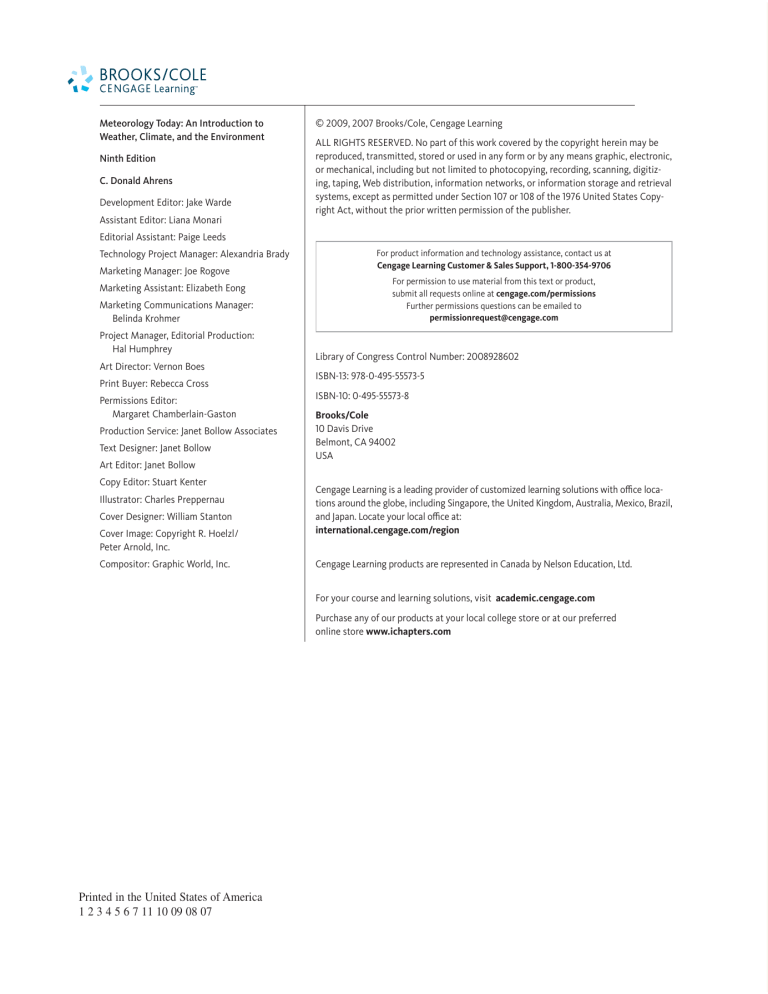
Meteorology Today: An Introduction to
Weather, Climate, and the Environment
Ninth Edition
C. Donald Ahrens
Development Editor: Jake Warde
Assistant Editor: Liana Monari
© 2009, 2007 Brooks/Cole, Cengage Learning
ALL RIGHTS RESERVED. No part of this work covered by the copyright herein may be
reproduced, transmitted, stored or used in any form or by any means graphic, electronic,
or mechanical, including but not limited to photocopying, recording, scanning, digitizing, taping, Web distribution, information networks, or information storage and retrieval
systems, except as permitted under Section 107 or 108 of the 1976 United States Copyright Act, without the prior written permission of the publisher.
Editorial Assistant: Paige Leeds
Technology Project Manager: Alexandria Brady
Marketing Manager: Joe Rogove
Marketing Assistant: Elizabeth Eong
Marketing Communications Manager:
Belinda Krohmer
Project Manager, Editorial Production:
Hal Humphrey
Art Director: Vernon Boes
Print Buyer: Rebecca Cross
Permissions Editor:
Margaret Chamberlain-Gaston
Production Service: Janet Bollow Associates
Text Designer: Janet Bollow
Art Editor: Janet Bollow
Copy Editor: Stuart Kenter
Illustrator: Charles Preppernau
Cover Designer: William Stanton
Cover Image: Copyright R. Hoelzl/
Peter Arnold, Inc.
Compositor: Graphic World, Inc.
For product information and technology assistance, contact us at
Cengage Learning Customer & Sales Support, 1-800-354-9706
For permission to use material from this text or product,
submit all requests online at cengage.com/permissions
Further permissions questions can be emailed to
permissionrequest@cengage.com
Library of Congress Control Number: 2008928602
ISBN-13: 978-0-495-55573-5
ISBN-10: 0-495-55573-8
Brooks/Cole
10 Davis Drive
Belmont, CA 94002
USA
Cengage Learning is a leading provider of customized learning solutions with office locations around the globe, including Singapore, the United Kingdom, Australia, Mexico, Brazil,
and Japan. Locate your local office at:
international.cengage.com/region
Cengage Learning products are represented in Canada by Nelson Education, Ltd.
For your course and learning solutions, visit academic.cengage.com
Purchase any of our products at your local college store or at our preferred
online store www.ichapters.com
Printed in the United States of America
1 2 3 4 5 6 7 11 10 09 08 07
Atmospheric Humidity
Over land, a considerable amount of water vapor is
added to the atmosphere through evaporation from the soil,
lakes, and streams. Even plants give up moisture by a process
called transpiration. The water absorbed by a plant’s root
system moves upward through the stem and emerges from
the plant through numerous small openings on the underside
of the leaf. In all, evaporation and transpiration from continental areas amount to only about 15 percent of the nearly
1.5 billion billion gallons of water vapor that annually evaporate into the atmosphere; the remaining 85 percent evaporates from the oceans. If all of this water vapor were to suddenly condense and fall as rain, it would be enough to cover
the entire globe with 2.5 centimeters, (or 1 inch) of water.*
The total mass of water vapor stored in the atmosphere at any
moment adds up to only a little over a week’s supply of the
world’s precipitation. Since this amount varies only slightly
from day to day, the hydrologic cycle is exceedingly efficient
in circulating water in the atmosphere.
The Many Phases of Water
If we could see individual water molecules, we would find
that, in the lower atmosphere, water is everywhere. If we
could observe just one single water molecule by magnifying
it billions of times, we would see an H2O molecule in the
shape of a tiny head that somewhat resembles Mickey Mouse
(see ● Fig. 4.2). The bulk of the “head” of the molecule is the
oxygen atom. The “mouth” is a region of excess negative
charge. The “ears” are partially exposed protons of the hydrogen atom, which are regions of excess positive charge.
When we look at many H2O molecules , we see that, as a
gas, water vapor molecules move about quite freely, mixing
well with neighboring atoms and molecules (see ● Fig. 4.3).
As we learned in Chapter 2, the higher the temperature of the
gas, the faster the molecules move. In the liquid state, the
water molecules are closer together, constantly jostling and
bumping into one another. If we lower the temperature of the
liquid, water molecules would move slower and slower until,
when cold enough, they arrange themselves into an orderly
pattern with each molecule more or less locked into a rigid
position, able to vibrate but not able to move about freely. In
this solid state called ice, the shape and charge of the water
molecule helps arrange the molecules into six-sided (hexagonal) crystals.
As we observe the ice crystal in freezing air, we see an occasional molecule gain enough energy to break away from its
neighbors and enter into the air above. The molecule changes
from an ice molecule directly into a vapor molecule without
passing through the liquid state. This ice-to-vapor phase
change is called sublimation. If a water vapor molecule
should attach itself to the ice crystal, the vapor-to-ice phase
change is called deposition. If we apply warmth to the ice
*If the water vapor in a column of air condenses and falls to the earth as rain, the
depth of the rain on the surface is called precipitable water.
●
91
F I G U R E 4 . 2 The water molecule.
crystal, its molecules would vibrate faster. In fact, some of the
molecules would actually vibrate out of their rigid crystal
pattern into a disorderly condition — that is, the ice melts.
And so water vapor is a gas that becomes visible to us
only when millions of molecules join together to form tiny
cloud droplets or ice crystals. In this process — known as a
change of state or, simply, phase change — water only changes
its disguise, not its identity.
Evaporation, Condensation,
and Saturation
Suppose we were able to observe individual water molecules
in a beaker, as illustrated in ● Fig. 4.4a. What we would see are
water molecules jiggling, bouncing, and moving about. However, we would also see that the molecules are not all moving
●
F I G U R E 4 . 3 The three states of matter. Water as a gas, as a liquid,
and as a solid.
92
CHAPTER 4
● F I G U R E 4 . 4 (a) Water molecules at the surface of the water are
evaporating (changing from liquid into vapor) and condensing (changing from vapor into liquid). Since more molecules are evaporating than
condensing, net evaporation is occurring. (b) When the number of water molecules escaping from the liquid (evaporating) balances those returning (condensing), the air above the liquid is saturated with water
vapor. (For clarity, only water molecules are illustrated.)
at the same speed — some are moving much faster than others. At the surface, molecules with enough speed (and traveling in the right direction) would occasionally break away
from the liquid surface and enter into the air above. These
molecules, changing from the liquid state into the vapor state
are evaporating. While some water molecules are leaving the
liquid, others are returning. Those returning are condensing
as they are changing from a vapor state to a liquid state.
When a cover is placed over the beaker (see Fig. 4.4b),
after a while the total number of molecules escaping from the
liquid (evaporating) would be balanced by the number re-
F I G U R E 4 . 5 Condensation is more likely to occur as the air cools.
(a) In the warm air, fast-moving H2O vapor molecules tend to bounce
away after colliding with nuclei. (b) In the cool air, slow-moving vapor
molecules are more likely to join together on nuclei. The condensing of
many billions of water molecules produces tiny liquid water droplets.
●
turning (condensing). When this condition exists, the air is
said to be saturated with water vapor. For every molecule
that evaporates, one must condense, and no net loss of liquid
or vapor molecules results.
If we remove the cover and blow across the top of the
water, some of the vapor molecules already in the air above
would be blown away, creating a difference between the actual number of vapor molecules and the total number required for saturation. This would help prevent saturation
from occurring and would allow for a greater amount of
evaporation. Wind, therefore, enhances evaporation.
The temperature of the water also influences evaporation. All else being equal, warm water will evaporate more
readily than cool water. The reason for this phenomenon is
that, when heated, the water molecules will speed up. At
higher temperatures, a greater fraction of the molecules have
sufficient speed to break through the surface tension of the
water and zip off into the air above. Consequently, the
warmer the water, the greater the rate of evaporation.
If we could examine the air above the water in Fig. 4.4b,
we would observe the water vapor molecules freely darting
about and bumping into each other as well as neighboring
molecules of oxygen and nitrogen. When these gas molecules
collide, they tend to bounce off one another, constantly
changing in speed and direction. However, the speed lost by
one molecule is gained by another, and so the average speed
of all the molecules does not change. Consequently, the temperature of the air does not change. Mixed in with all of the
air molecules are microscopic bits of dust, smoke, salt, and
other particles called condensation nuclei (so-called because
water vapor condenses on them). In the warm air above the
water, fast-moving vapor molecules strike the nuclei with
such impact that they simply bounce away (see ● Figure 4.5a).
However, if the air is chilled (Fig. 4.5b), the molecules move
more slowly and are more apt to stick and condense to the
nuclei. When many billions of these vapor molecules condense onto the nuclei, tiny liquid cloud droplets form.
We can see then that condensation is more likely to happen as the air cools and the speed of the vapor molecules
decreases. As the air temperature increases, condensation is
less likely because most of the molecules have sufficient speed
(sufficient energy) to remain as a vapor. As we will see in this
and other chapters, condensation occurs primarily when the
air is cooled.*
Even though condensation is more likely to occur when
the air cools, it is important to note that no matter how cold
the air becomes, there will always be a few molecules with
sufficient speed (sufficient energy) to remain as a vapor. It
should be apparent, then, that with the same number of water vapor molecules in the air, saturation is more likely to
occur in cool air than in warm air. This idea often leads to the
statement that “warm air can hold more water vapor molecules before becoming saturated than can cold air” or, simply,
*As we will see later, another way of explaining why cooling produces condensation is that the saturation vapor pressure decreases with lower temperatures.
Atmospheric Humidity
93
“warm air has a greater capacity for water vapor than does
cold air.” At this point, it is important to realize that although
these statements are correct, the use of such words as “hold”
and “capacity” are misleading when describing water vapor
content, as air does not really “hold” water vapor in the sense
of making “room” for it.
Humidity
We are now ready to look more closely at the concept of
humidity, which may refer to any one of a number of ways
of specifying the amount of water vapor in the air. Since
there are several ways to express atmospheric water vapor
content, there are several meanings for the concept of humidity. The first type of humidity we’ll take a look at is absolute
humidity.
ABSOLUTE HUMIDITY Suppose we enclose a volume of air
in an imaginary thin elastic container — a parcel — about the
size of a large balloon, as illustrated in ● Fig. 4.6. With a
chemical drying agent, we can extract the water vapor from
the air, weigh it, and obtain its mass. If we then compare the
vapor’s mass with the volume of air in the parcel, we would
have determined the absolute humidity of the air — that is,
the mass of water vapor in a given volume of air, which can
be expressed as
Absolute humidity !
F I G U R E 4 . 7 With the same amount of water vapor in a
parcel of air, an increase in volume decreases absolute humidity,
whereas a decrease in volume increases absolute humidity.
●
mass of water vapor
.
volume of air
Absolute humidity represents the water vapor density (mass/
volume) in the parcel and, normally, is expressed as grams of
water vapor in a cubic meter of air. For example, if the water
vapor in 1 cubic meter of air weighs 25 grams, the absolute
humidity of the air is 25 grams per cubic meter (25 g/m3).
We learned in Chapter 2 that a rising or descending parcel
of air will experience a change in its volume because of the
changes in surrounding air pressure. Consequently, when a
volume of air fluctuates, the absolute humidity changes — even
though the air’s vapor content has remained constant (see
● Fig. 4.7). For this reason, the absolute humidity is not commonly used in atmospheric studies.
SPECIFIC HUMIDITY AND MIXING RATIO Humidity,
however, can be expressed in ways that are not influenced by
changes in air volume. When the mass of the water vapor in
the air parcel in Fig. 4.6 is compared with the mass of all the
air in the parcel (including vapor), the result is called the
specific humidity; thus
Specific humidity !
mass of water vapor
.
total mass of air
Another convenient way to express humidity is to compare the mass of the water vapor in the parcel to the mass of
the remaining dry air. Humidity expressed in this manner is
called the mixing ratio; thus
mass of water vapor
Mixing ratio !
.
mass of dry air
F I G U R E 4 . 6 The water vapor content (humidity) inside
this air parcel can be expressed in a number of ways.
●
Both specific humidity and mixing ratio are expressed as
grams of water vapor per kilogram of air (g/kg).
The specific humidity and mixing ratio of an air parcel
remain constant as long as water vapor is not added to or removed from the parcel. This happens because the total number of molecules (and, hence, the mass of the parcel) remains
constant, even as the parcel expands or contracts (see
● Fig. 4.8). Since changes in parcel size do not affect specific
humidity and mixing ratio, these two concepts are used extensively in the study of the atmosphere.
● Figure 4.9 shows how specific humidity varies with
latitude. The average specific humidity is highest in the
warm, muggy tropics. As we move away from the tropics, it
decreases, reaching its lowest average value in the polar latitudes. Although the major deserts of the world are located
94
●
CHAPTER 4
F I G U R E 4 . 8 The specific humidity does not change as air rises
and descends.
near latitude 30°, Fig. 4.9 shows that, at this latitude, the average air contains nearly twice the water vapor than does the air
at latitude 50°N. Hence, the air of a desert is certainly not
“dry,” nor is the water vapor content extremely low. Since the
hot, desert air of the Sahara often contains more water vapor
than the cold, polar air farther north, we can say that summertime Sahara air has a higher specific humidity. (We will see
later in what sense we consider desert air to be “dry.”)
VAPOR PRESSURE The air’s moisture content may also be
described by measuring the pressure exerted by the water vapor in the air. Suppose the air parcel in Fig. 4.6, (p. 93), is near
sea level. The total pressure inside the parcel is due to the collision of all the molecules against the inside surface of the
parcel. In other words, the total pressure inside the parcel is
equal to the sum of the pressures of the individual gases. (This
phenomenon is known as Dalton’s law of partial pressure.) If
● F I G U R E 4 . 9 The average specific humidity for each latitude. The
highest average values are observed in the tropics and the lowest values
in polar regions.
the total pressure inside the parcel is 1000 millibars (mb),*
and the gases inside include nitrogen (78 percent), oxygen (21
percent), and water vapor (1 percent), then the partial pressure exerted by nitrogen would be 780 mb and by oxygen, 210
mb. The partial pressure of water vapor, called the actual vapor pressure, would be only 10 mb (1 percent of 1000).† It is
evident, then, that because the number of water vapor molecules in any volume of air is small compared to the total number of air molecules in the volume, the actual vapor pressure
is normally a small fraction of the total air pressure.
Everything else being equal, the more air molecules in a
parcel, the greater the total air pressure. When you blow up
a balloon, you increase its pressure by putting in more air.
Similarly, an increase in the number of water vapor molecules will increase the total vapor pressure. Hence, the actual
vapor pressure is a fairly good measure of the total amount
of water vapor in the air: High actual vapor pressure indicates
large numbers of water vapor molecules, whereas low actual
vapor pressure indicates comparatively small numbers of vapor
molecules.‡
In summer across North America, the highest vapor
pressures are observed along the humid Gulf Coast, whereas
the lowest values are experienced over the drier Great Basin,
especially Nevada. In winter, the highest average vapor pressures are again observed along the Gulf Coast with lowest
values over the northern Great Plains into Canada.
Actual vapor pressure indicates the air’s total water vapor
content, whereas saturation vapor pressure describes how
much water vapor is necessary to make the air saturated at any
given temperature. Put another way, saturation vapor pressure
is the pressure that the water vapor molecules would exert if the
air were saturated with vapor at a given temperature.§
We can obtain a better picture of the concept of saturation vapor pressure by imagining molecules evaporating
from a water surface. Look back at Fig. 4.4b, (p. 92) and recall
that when the air is saturated, the number of molecules escaping from the water’s surface equals the number returning.
Since the number of “fast-moving” molecules increases as the
temperature increases, the number of water molecules escaping per second increases also. In order to maintain equilibrium, this situation causes an increase in the number of water
vapor molecules in the air above the liquid. Consequently, at
higher air temperatures, it takes more water vapor to saturate
the air. And more vapor molecules exert a greater pressure.
Saturation vapor pressure, then, depends primarily on the air
temperature. From the graph in ● Fig. 4.10, we can see that at
*You may recall from Chapter 1 that the millibar is the unit of pressure most commonly found on surface weather maps, and that it expresses atmospheric pressure
as a force over a given area.
†When we use the percentages of various gases in a volume of air, Dalton’s law
only gives us an approximation of the actual vapor pressure. The point here is that,
near the earth’s surface, the actual vapor pressure is often close to 10 mb.
‡Remember that actual vapor pressure is only an approximation of the total vapor
content. A change in total air pressure will affect the actual vapor pressure even
though the total amount of water vapor in the air remains the same.
§When the air is saturated, the amount of water vapor is the maximum possible at
the existing temperature and pressure.
Atmospheric Humidity
95
10°C, the saturation vapor pressure is about 12 mb, whereas
at 30°C it is about 42 mb.
The insert in Fig. 4.10 shows that, when both water and
ice exist at the same temperature below freezing, the saturation vapor pressure just above the water is greater than the
saturation vapor pressure over the ice. In other words, at any
temperature below freezing, it takes more vapor molecules to
saturate air directly above water than it does to saturate air
directly above ice. This situation occurs because it is harder
for molecules to escape an ice surface than a water surface.
Consequently, fewer molecules escape the ice surface at a
given temperature, requiring fewer in the vapor phase to
maintain equilibrium. Likewise, salts in solution bind water
molecules, reducing the number escaping. These concepts are
important and (as we will see in Chapter 7) play a role in the
process of rain formation.
So far, we’ve described the amount of moisture actually
in the air. If we want to report the moisture content of the air
around us, we have several options:
1. Absolute humidity tells us the mass of water vapor in a
fixed volume of air, or the water vapor density.
2. Specific humidity measures the mass of water vapor in a
fixed total mass of air, and the mixing ratio describes the
mass of water vapor in a fixed mass of the remaining dry
air.
3. The actual vapor pressure of air expresses the amount of
water vapor in terms of the amount of pressure that the
water vapor molecules exert.
4. The saturation vapor pressure is the pressure that the water
vapor molecules would exert if the air were saturated with
vapor at a given temperature.
Each of these measures has its uses but, as we will see, the
concepts of vapor pressure and saturation vapor pressure are
critical to an understanding of the sections that follow. (Before looking at the most commonly used moisture variable — relative humidity — you may wish to read the Focus
section on vapor pressure and boiling, p. 96.)
RELATIVE HUMIDITY While relative humidity is the most
common way of describing atmospheric moisture, it is also,
unfortunately, the most misunderstood. The concept of relative humidity may at first seem confusing because it does not
indicate the actual amount of water vapor in the air. Instead,
it tells us how close the air is to being saturated. The relative
humidity (RH) is the ratio of the amount of water vapor actually in the air to the maximum amount of water vapor required
for saturation at that particular temperature (and pressure). It
is the ratio of the air’s water vapor content to its capacity;
thus
water vapor content
.
RH !
water vapor capacity
We can think of the actual vapor pressure as a measure of the
air’s actual water vapor content, and the saturation vapor
A C T I V E F I G U R E 4 .1 0 Saturation vapor pressure increases with
increasing temperature. At a temperature of 10°C, the saturation vapor
pressure is about 12 mb, whereas at 30°C it is about 42 mb. The insert
illustrates that the saturation vapor pressure over water is greater than
the saturation vapor pressure over ice.
Visit the Meteorology Resource Center to view this and other active
figures at academic.cengage.com/login
pressure as a measure of air’s total capacity for water vapor.
Hence, the relative humidity can be expressed as
actual vapor pressure
RH !
"100 percent .*
saturation vapor pressure
Relative humidity is given as a percent. Air with a 50 percent
relative humidity actually contains one-half the amount required for saturation. Air with a 100 percent relative humidity is
said to be saturated because it is filled to capacity with water
vapor. Air with a relative humidity greater than 100 percent is
said to be supersaturated. Since relative humidity is used so
much in the everyday world, let’s examine it more closely.
*Relative humidity may also be expressed as
RH !
actual mixing ratio
"100 percent,
saturation mixing ratio
where the actual mixing ratio is the mixing ratio of the air, and the saturation
mixing ratio is the mixing ratio of saturated air at that particular temperature.




